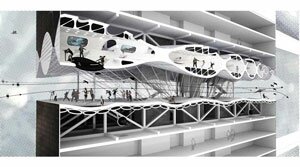ONARCHITECTURE- Intelligent design: Will robots take over architecture?

Look out George Jetson: It's the Super Gallaxy II, a high-rise apartment complex that's constantly in motion and responds to the needs of its inhabitants.
Photo Courtesy Jason Johnson and Nataly Gattegno, Future Cities Lab
What if a building could build, repair, dismantle, and recycle itself? What if a building were equipped with sensors to track your movement through a space and could adapt its shape, texture, light, sounds, and heat to your presence? Finally, what if you could talk to a building and it could talk back?
Those are the kinds of questions students in UVA architecture professor Jason Johnson's Robotic Ecologies seminar are encouraged to ask and explore.
As Johnson admits, they aren't questions architects normally ask, but they're becoming commonplace in the fields of artificial intelligence, robotics, and materials science. Indeed, when we spoke to UVA materials science professor William Jesser last year about the opening of Wilsdorf Hall, the new state-of-the art facility equipped for research on nanotechnology, he spoke matter-of-factly about programing dust particles, or "smart dust," to track movements or measure temperature and humidity.
"Robotic Ecologies refers to an emerging condition that is rapidly influencing our relationship with the physical environment," says Johnson. "The gradual intermeshing of technological and computational systems into the physical realm has both positive and negative implications, many of which are currently under-explored or misunderstood by architects or planners."
One of those negative implications is the evolution of our surveillance society. For example, Johnson points out that the U.S. government has begun a $7.5 billion project to create a 1,900-mile "virtual border" between the U.S. and Mexico that will be a combination of physical barriers and fences, with integrated sound and video sensors, surveillance cameras, and swarms of roving robotic vehicles. A similar border zone, says Johnson, is being constructed by the South Koreans.
"These are frightening robotic ecologies occurring on a massive territorial scale," he says. "There are many examples with varying degrees of intensity that I often cite in seminar discussions. Nevertheless, we try to focus on the more optimistic opportunities afforded by the intersection of architecture and robotics."
While none of us will be living like the Jetsons anytime soon, architects like Johnson are beginning to incorporate these ideas into the study of designs for the future, some of which were on display locally a few weeks ago.
On May 5 at the McGuffey Art Center, the optimistic fruits of Johnson's seminar, which were referred to as prototypes of the "crossbreeding of architecture and robotics" were on display.
Included were the Rave, a mutating scissor-like structure that actively stores solar energy during the day to create a dynamic dance space with light, sound, and pulsations at night; the Iris, a layered facade that could potentially sense and optimize itself relative to air flow, light levels, and pollutant levels; and the Tilt, an aerodynamically calibrated high-rise building prototype that adjusts the shape of its woven floor plates from a circle to an ellipse in response to weather conditions, while an array of LED displays register wind velocity, temperatures, and the movements of people inside.
"Robots can sense scenarios unfolding, make a plan based on past and present experiences, and then act in an appropriate way," says Johnson. "What makes robots so intriguing is their ability to learn and optimize through feeding back information into these phases."
As Johnson observes, robots are getting smaller, smarter, and cheaper, and can be interconnected using WiFi, radio, bluetooth, and other technologies.
"It is now more efficient and economical to build and deploy lots of small clusters of networked expendable robots than a single expensive one," says Johnson. "These robots are now being incorporated into biological entities, into urban streetscapes for monitoring, and into industry for control and efficiency."
In this vision of the future, Johnson imagines, architecture will be in constant negotiation with the energy cycles of its surroundings and with the needs of its inhabitants. Likening such architecture to airplane design, Johnson says that some elements of the design will be "pre-shaped" and stationary, while other elements will be "active, dynamic and form-seeking."
Indeed, Johnson and his colleague Nataly Gattegno have begun to explore these possibilities in their Future Cities Lab, a design research collaborative that explores the outer-reaches of architecture, including buildings that produce their own energy, hover over sidewalks and public spaces, and are constantly in motion as they respond to the needs of their inhabitants.
Buildings that prepare for the evening's Rave party? Facades that sense your presence? High-rise buildings that respond to weather? At this rate, our buildings might become smarter than we are.
#
6 comments
later
shame on you for bringing up the name Hitler
you display your ignorance i.e. if you make the rules you have no debate no discussion
the internet gives everyone a chance to see the real picture and not just the politicaly correct version
ignorance is bliss!!!!!!!!!!!!!!
Dangerously intriguing.
Robots are going to take over smart bombs will turn most of the military today is run by robots
Will we see stores that change their merchandise displays in response to how visitors are dressed?
u r to cool